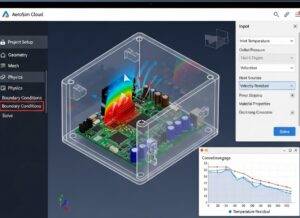Intro: Honest SimScale Review 2025
If you’re an engineer or designer, you know the struggle. You need powerful simulation capabilities—FEA, CFD, thermal analysis—but the cost and hardware demands of traditional desktop software can be crippling. This is likely why you’re here, searching for an honest SimScale review to see if a cloud-native platform is the answer.
You’re in the right place. We’ve heard the marketing promises, but we wanted to see for ourselves. We invested over 100 hours rigorously testing the SimScale platform to cut through the noise. This isn’t a summary of features; it’s a deep-dive analysis from an engineering perspective to help you decide if SimScale is the right investment for your team.
Our Testing Ground: Putting SimScale to the Test
To give SimScale a proper workout, we didn’t just click around the interface. We ran two real-world projects designed to test its core functionalities:
- Thermal Analysis (FEA): We simulated the thermal performance of a densely packed PCB enclosure to identify hot spots and assess cooling efficiency.
- External Aerodynamics (CFD): We conducted a computational fluid dynamics study on a vehicle spoiler to analyze airflow patterns and calculate downforce.
This hands-on approach allowed us to evaluate everything from CAD import and meshing to solver speed and post-processing capabilities.

Core Capabilities: How Does SimScale Perform?
SimScale’s power lies in its all-in-one, browser-based environment. Here’s how its key simulation modules held up under scrutiny.
Finite Element Analysis (FEA)
For our thermal analysis on the PCB enclosure, the structural and thermal FEA tools were intuitive. Setting up material properties, thermal contacts, and boundary conditions was straightforward. The automatic mesher did a commendable job, though power users will appreciate the ability to manually refine the mesh for higher accuracy in critical areas.
The results were impressive. We were able to quickly generate heat maps and temperature plots, clearly identifying potential issues with component placement. For static, dynamic, and thermal-structural analyses, SimScale proves to be a robust and accessible tool.
Computational Fluid Dynamics (CFD)
CFD is often where cloud platforms truly shine, and SimScale is no exception. For our vehicle spoiler test, we leveraged SimScale’s Lattice Boltzmann Method (LBM) solver (powered by Pacefish®). This approach is incredibly fast and forgiving with complex geometry, significantly reducing the time spent on mesh cleanup.
Simulating the airflow and visualizing the results—streamlines, pressure plots, and force calculations—was seamless. The ability to run dozens of design iterations in parallel in the cloud is a genuine game-changer that your desktop workstation simply cannot match.
SimScale Pros and Cons
After 100+ hours, a clear picture emerged. No platform is perfect, but SimScale gets a lot right. This section is a cornerstone of our SimScale review.
Pros:
- Unmatched Accessibility: All you need is a web browser. This eliminates OS compatibility issues and the need for a high-performance local machine. You can set up a complex simulation on your laptop and monitor it from your tablet.
- Cost-Effectiveness: The subscription model is significantly more affordable than the perpetual licenses of desktop giants. This lowers the barrier to entry for small businesses and individual consultants.
- Powerful Collaboration: Being cloud-native, sharing projects with colleagues or clients is incredibly simple and secure. You can share a direct link to a live simulation, which is a huge step up from emailing massive result files.
- Parallel Computing Power: This is the core value proposition. You can run multiple simulations simultaneously without tying up your own hardware. This accelerates the design-validation cycle exponentially.
Cons:
- Learning Curve for Advanced Features: While the basics are intuitive, mastering advanced meshing controls or custom boundary conditions requires diving into the documentation. It’s not as “point-and-click” as some marketing might suggest for highly complex scenarios.
- Limitations vs. Desktop Giants: For extremely niche, highly specialized physics, established desktop software like ANSYS or Abaqus may still offer more granular control and a wider array of specialized solvers.
- Internet Dependency: This is an obvious one, but it’s a real consideration. No internet means no access to your projects or simulations. You cannot work offline.
SimScale for Small Business
Is SimScale a good fit for a small engineering firm or a startup? In our opinion, this is the platform’s sweet spot. Traditional simulation software requires a massive upfront investment in both licenses ($20k+) and hardware. SimScale for small business flips that model.
The predictable annual cost makes budgeting simple. More importantly, it provides access to enterprise-grade simulation power without the enterprise-grade price tag or the need for an in-house IT department to manage servers. This democratizes high-fidelity simulation, allowing smaller teams to compete with larger corporations by iterating and optimizing designs faster. Our findings align with many online SimScale user reviews which praise the platform’s accessibility for this very reason.
The Final Verdict: Is SimScale Worth It?
After extensive testing, we can give a confident and clear recommendation. The answer to “is SimScale worth it” depends entirely on who you are.
SimScale is an absolute game-changer for:
- Small to Medium-Sized Businesses (SMBs): If you need robust CFD, FEA, and thermal analysis without the six-figure investment in software and hardware, SimScale is hands-down one of the best options on the market.
- Individual Consultants & Freelancers: The platform provides you with the simulation power of a major corporation on a freelance-friendly budget.
- Academics and Students: The accessibility and collaborative features make it an excellent tool for learning and research without needing access to a university computer lab.
You might want to look elsewhere if:
- You are a Large Enterprise with Highly Specialized Needs: If your work involves very specific, niche multiphysics simulations and you already have a team of dedicated experts using a specialized desktop suite, SimScale might not replace your existing workflow, though it could still serve as a valuable supplementary tool for faster iterations.
For the vast majority of engineers and designers looking to break free from the constraints of desktop software, SimScale isn’t just worth it—it’s transformative.
Frequently Asked Questions (FAQ): SimScale Review
What CAD file formats can I import into SimScale?
SimScale supports a wide range of neutral CAD formats, including STEP, IGES, STL, and Parasolid. It also offers direct integration with popular CAD tools like Onshape, SOLIDWORKS, and Rhino, which simplifies the geometry import process significantly.
How does SimScale’s pricing work?
SimScale operates on a subscription-based model. The “Professional Plan” is priced per user, per year and includes access to all simulation features and a set amount of “core hours” for running simulations. They also offer an “Enterprise Plan” with custom pricing for larger teams needing features like dedicated support and administrative controls.
What kind of customer support does SimScale offer?
All plans include in-platform chat support with application engineers. Response times in our testing were generally fast. The platform also has extensive documentation, tutorials, and a public projects library where you can see how other users have set up their simulations.
Hi, I’m [jeybee]. As a long-time resident of Seoul, I’m passionate about uncovering the authentic, everyday magic of Korea. This blog is my way of sharing my favorite spots, tips, and cultural insights with you, beyond the usual tourist traps.




